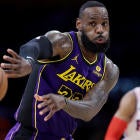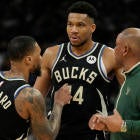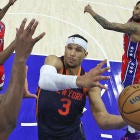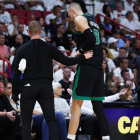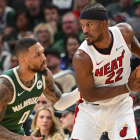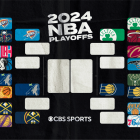On this date a year ago, yours truly was dealing with the evils of sleep-deprivation and the psychological torture inflicted by 149 days of NBA lockout coverage. While hallucinating, I dutifully studied the term sheets released by both sides after a deal finally was struck on a new collective bargaining agreement, trying to compute what it would all mean.
In the short term, it meant no more loitering in fancy hotel lobbies or on busy Manhattan sidewalks, no more outrageous parking bills from the Waldorf Astoria and no more takeout orders delivered to some random front stoop for the vagrants reporting on the work stoppage in person.
Lockout humor persists; I recently joked with Howard Beck of The New York Times, who like me covered nearly every bargaining session of the five-month affair, to be careful on his ride home from a Nets game because there was "a lot of traffic on the 47 percent highway." This would've been considered amusing if we both weren't still suffering symptoms of P.T.L.D -- post-traumatic lockout disorder. As I recall, Howard did not laugh.
In the end, the NBA not only survived the lockout but has thrived in its aftermath. The 66-game regular season resulted in only a 10 percent decline in league revenues despite the elimination of 20 percent of the season. TV ratings continued to soar, setting the league up for a massive increase in broadcast and digital rights when the current contracts with ABC/ESPN and TNT expire in 2016. A compelling postseason was punctuated by a thrilling NBA Finals that ultimately crowned LeBron James -- whose union with Dwyane Wade and Chris Bosh in Miami was one of many contributing factors to the owner angst that caused the lockout -- a champion for the first time.
About a month into the first full season since the work stoppage, business is better than ever. Storylines abound in markets large (L.A., New York) and small (Oklahoma City, Charlotte), and outgoing commissioner David Stern recently floated the possibility of league revenues hitting $5 billion this season -- a 20 percent increase over the last full season in 2010-11.
Lest we forget the league's two goals in the lockout -- reducing player costs and creating a system in which all 30 teams, if well managed, could be competitive and have the opportunity to make a profit -- it isn't too early to take a look at what, if anything, the lockout accomplished in both regards. It is too early to draw final, sweeping conclusions. But on the one-year mark since the lockout ended -- shortly after 3 a.m. ET on Nov. 26, 2011 -- it's as good a time as any to take stock.
As far as reducing player costs as a percentage of revenues, that goal was achieved almost immediately. The players' share of basketball-related income (BRI) was reduced from 57 percent under the previous agreement to 51.15 percent for the 2011-12 season and to a sliding scale between 49 and 51 percent thereafter, based on revenues. The escrow system remains in place to account for any shortfall or overage in the amount of negotiated salaries.
How that reduction is being achieved will be the most interesting and important aspect of the agreement. With only one truncated and one full free-agent signing period under the agreement so far, it's too soon to conclude whether the player cost reductions are being achieved in a way that promotes competitive balance.
The salary cap has remained flat ($58.044 million) for three straight seasons during what league officials refer to as the "reset" under the new agreement. After the initial reset, player salaries and benefits will begin to grow again as revenues increase. Basically, it isn't as good a deal as the players had before. But it's far better than what they would've wound up with had they lost an entire season, suffered through a massive reduction in revenues and possibly received a lower percentage when they finally agreed to a deal.
The players were able to preserve the basic structure of the system governing player movement and individual contract limits that existed before, with the obvious caveats that maximum contract lengths are shorter by a year and annual increases are lower. While the players retained a menu of salary cap exceptions that they believed were critical to maintaining a system with free player movement, those exceptions have been curtailed for teams operating above the so-called luxury-tax "apron," or for those $4 million above the luxury-tax line (currently $70.3 million).
In 2013-14, the next phase of the competitive reset kicks in when the previous dollar-for-dollar luxury-tax penalties increase exponentially. Not only will tax-paying teams be unable to use various exceptions, acquire players via sign-and-trades or perform uneven financial trades, they will pay the piper if they choose to significantly exceed the tax threshold. The new rates next season, as we've been over numerous times, will be $1.50 for every dollar up to $5 million over the tax; $1.75 for $5 million-$10 million over; and on and on until a team will owe $3.75 for every dollar between $20 million and $25 million above the tax line, with 50 cents added for each $5 million beyond that. Even higher rates go into effect in 2014-15 for teams that exceed the tax for a fourth straight season, and in 2015-16 for repeat offenders in four of the past five seasons.
Teams also were given new tools to help them navigate cap-and-tax hell in the form of the amnesty and stretch provisions. So far, 15 teams have used amnesty to waive a player signed to an onerous contract under the previous CBA and wipe it from its cap and tax figures (though the player, of course, must still be paid). For contracts signed under the current CBA, teams can waive the player and stretch his obligations out over a longer period to ease the cap-and-tax burdens.
Given that half the league still hasn't used its get-out-of-jail-free amnesty card, and the stretch provision hasn't come into play yet with only two free-agent periods under the new agreement, it's difficult to measure how the new provisions have affected competitive balance. Same goes for the steeper tax rates that have yet to go into effect, though teams already have begun planning to avoid the penalties. The Knicks let Jeremy Lin go to Houston as a restricted free agent; the Mavs have planned for all but five contracts to expire after this season; the Thunder traded James Harden rather than max him out with an extension; and the Bulls, projected to be taxpayers for the first time this season, dumped key rotation players Kyle Korver, Ronnie Brewer and C.J. Watson.
For those reasons and more, if you're looking for a dramatic flattening of the NBA's payroll disparity -- a key metric for measuring the haves vs. the have-nots -- you won't find it. Not yet.
According to league salary sheets obtained by CBSSports.com, the top eight highest-paid teams had an average payroll of $79 million at the end of the 2010-11 season (the last under the old agreement) compared to $55 million for the bottom eight. Now? Based on the salary books for this season so far, the disparity is almost identical -- an $80 million average salary for the top eight vs. $55 million for the bottom eight.
In '10-11, the middle 14 teams accounted for 47 percent of league payroll with a tight range of $65 million-$70 million. So far this season, the middle 14 account for 46 percent of projected league-wide payroll -- but with a wider disparity within that range, from $61 million-$70 million.
Though the analysis is incomplete, the NBA's new competitive model has done nothing yet to decrease the payroll disparity among the highest- and lowest-paid teams. In fact, the data show that payrolls in the bottom eight have not moved toward the low end of the middle; to the contrary, the teams at the low end of the middle have moved closer to those at the bottom.
So back to the question that I was pondering in my post-marathon-bargaining-session haze on this date one year ago: What does it all mean? For one, the NBA has rebounded from the lockout in robust fashion, with revenues and ratings continuing their ascent amid compelling storylines and palpable buzz. Though players no longer are guaranteed a clear majority of the money, they'll do better and better under this agreement as the NBA continues its hand-over-fist monetary gains.
As for owners, not all of them are happy; this is rarely the case, anyway. But league officials have projected that the league as a whole will be profitable this season after losing an average of $300 million a year under the previous six-year CBA. With a new revenue-sharing formula that the owners are still tweaking (read: arguing about), outgoing commissioner Stern has predicted that 25 of the NBA's 30 teams will be profitable by next season. In fact, Stern said last month at the Board of Governors press conference that the CBA is working so well for the owners that it gave him license to announce his retirement, which will happen on Feb. 1, 2014. Deputy commissioner Adam Silver, the league's lead negotiator on the past three CBAs, will take over.
Among other key figures from the lockout, National Basketball Players Association executive director Billy Hunter awaits the release of a review of the union's finances and business practices by a Manhattan law firm. The findings, expected to be divulged in the next two weeks, could have a direct bearing on Hunter's future as head of the union.
Derek Fisher remains president of the union despite deep disagreements with Hunter and a unanimous vote by fellow players on the executive committee that he should resign. Fisher, a five-time champion with the Lakers, also remains a free agent as he has been unable to persuade a team to hire him at the $1.4 million veteran's minimum at age 38.
And, finally, as to whether the league's new competitive model has resulted in a more competitive NBA -- one in which well-managed teams really do have an equal chance to compete for a championship regardless of market size -- the jury remains out.
Check back with me a year from now. By then, we should have a better idea of whether I'll be tweeting from some sidewalk in 2017, when the next lockout can begin.














